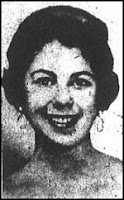Rose Lipner, age 32, mother of 2, died at Riverdale Hospital on January 29, 1936. Rose was buried the next day at Mount Judah Cemetery in Cypress Hills, New York. After the funeral, several people, including an anonymous caller, notified police and the District Attorney's office that the death was suspicious, and Rose was exhumed for an autopsy. The medical examiner determined that Rose had died from an abortion. Katz was arraigned for second-degree manslaughter.
Dr. Maxwell C. Katz, who owned and lived at Riverdale (maternity) Hospital, which he operated, signed a death certificate indicating that Rose had been operated on there for a tumor.
During his trial, his defense brought forth a large number of character witnesses testifying to Katz's 25 years as a physician and his good reputation. Katz did admit to performing an abortion on Rose, but said that it was in an attempt to save her life. This defense was successful, and he was acquitted.
1883: A Chicago Midwife
On January 29, 1883, a Chicago widow named Adeline Savroch died in a carriage on the way home from having a criminal abortion performed by midwife Bertha Twachaus, who was held without bail for murder in Adeline's death. A saloon keeper named Julius Grosse, and his housekeeper, Celia Arlep or Ortlepp, were held as accessories.
1857: At the Doctor's House
Olive Ash worked for a farmer, Mr. Beckwith, in Vermont, in the summer and fall of 1857. She was about 19 years old, and she lived with the family during her employment. In the autumn of that year, Olive returned to her family home in Sutton. On December 28, 1857, Olive and her twin sister, Olivia, left their home and went by rail to the home of their cousin, Levi M. Aldrich, in Bradford, ostensibly to visit his widowed mother.
The sisters remained at Aldrich's home about two weeks, then said that they were going to meet some friends at the Fairlee depot for an excursion into New York or Massachusetts. Instead, when they arrived at Fairlee depot they took a wagon to the home and office of Dr. William Howard. On Friday, January 29, 1858, Olive's mother, Mahitable, got a telegram telling her to come to Howard's home. She quickly complied, and was there when her daughter died at about 6 in the evening. Dr. Howard got a coffin for Olive, and the twins' mother took her daughter's body by train to Sutton.
On February 3, Olive's body was exhumed
for an autopsy, which was performed the following day. The cause of Olive's death was obvious. There was a quantity of pus and
the cervix was nearly ragged with injuries. Dr. Frost believed that
Olive had hemorrhaged
due to the damage to her cervix.
Howard was released on bail of $600 for each woman's death.
During Howard's trial, Olivia testified about how her sister had come to such a sad end.
A February 19, 1858 article in the Orleans Independent Standard of Irasburgh, VT notes that, "Before the examination of Howard, information was brought from Stanstead that the body of a Miss Young of Stanstead, who had died at Howard's house in Bradford, on the 17th of January, had been examined by the physicians of Stanstead, who were satisfied that her death was also caused in the same manner as that of Miss Ashe. Other evidence also corroborated their opinion."
Howard was released on bail of $600 for each woman's death.
During Howard's trial, Olivia testified about how her sister had come to such a sad end.
Dr. Howard told the sisters that the abortion process would take three or four weeks. He gave Olive a concoction to drink two or three times. On the Friday the week after the sisters' arrival, Dr. Howard performed some sort of procedure on Olive as she lay on the bed in the room the twins shared. The following day, Dr. Howard performed another, similar, procedure on Olive, who clutched her sister's hand and reported great pain. Olive bled profusely. After this second operation, Olive kept to her bed.
That night, Dr. Howard performed yet another procedure, very painful for Olive to endure. This time he used instruments then reached in with his hand and pulled out a fetus, which Olivia reported as being about two-thirds the size of a newborn. Dr. Howard removed the fetus from the room, and Olivia never saw it again. Another witness testified that about two weeks after Dr. Howard's arrest, she saw one of Dr. Howard's dogs come out from underneath the office privy with something in its mouth. She made the dog drop what it was carrying and discovered it to be a fetus of about four or five months, in a state of decomposition. While she was looking at the fetus, another of the doctor's dogs snatched the fetus up and ran off with it.













